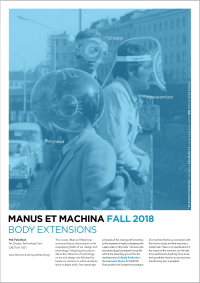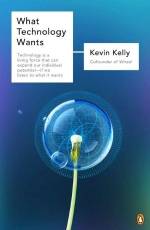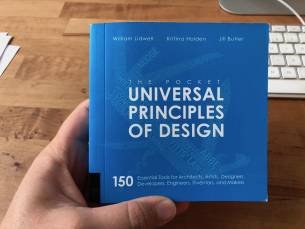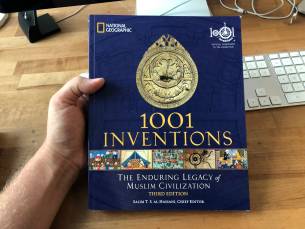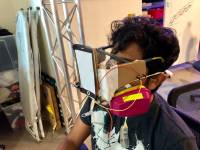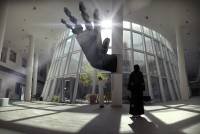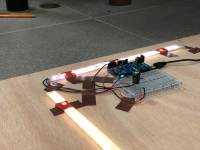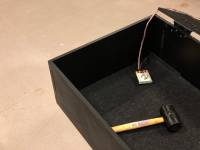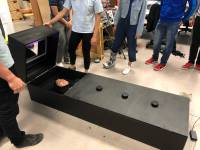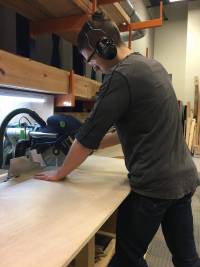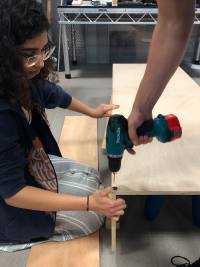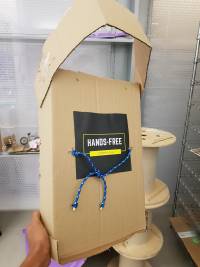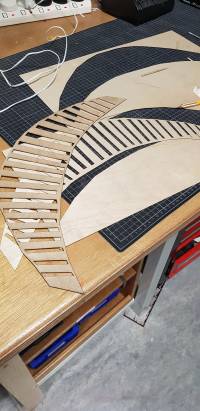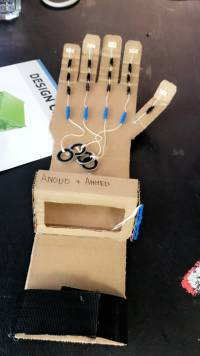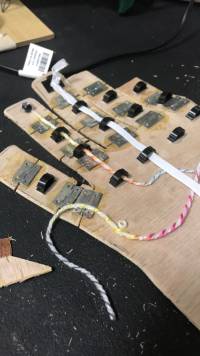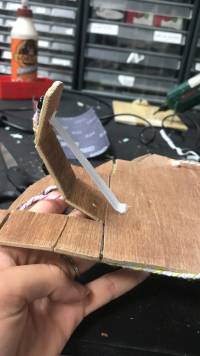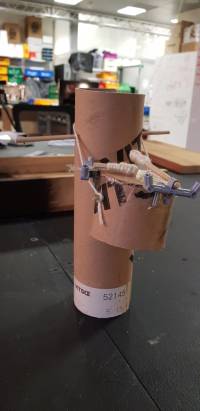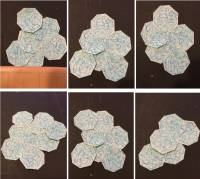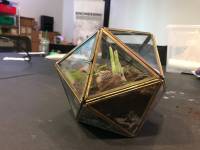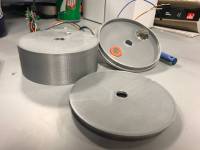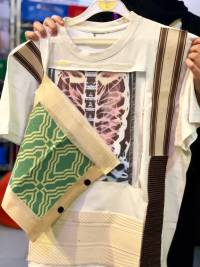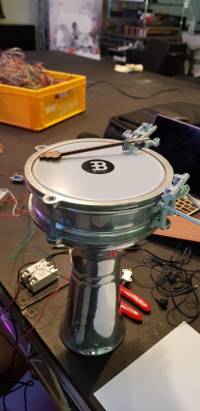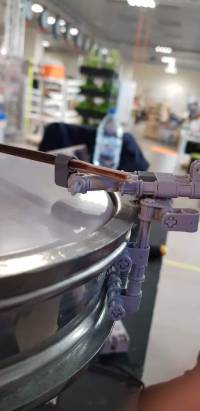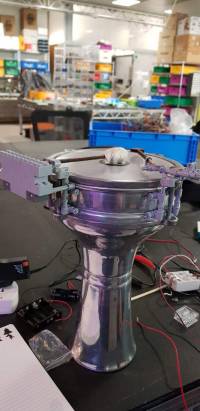Table of Contents
Manus Et Machina 2018
| Course Title: | Manus Et Machina |
| semester theme for Fall 2018: Body Extensions | |
| Course Number: | CADT-UH 1001 |
| Course Category: | Art, Design, and Technology (Core Competency Course) |
| Course Credit: | 4.0 points |
| Course Weeks: | 14 weeks |
| Contact Hours/Week: | Day 1, Project Colloquium: 155 min |
| Day 2, Seminar: 75 min | |
| Day 3, Seminar: 75 min | |
| Prerequisite: | There are no prerequisites for this course. |
Find the Weekly Schedule for Fall 2018 (incl. homework and due dates), the themes/dates for Case-Study Presentations , and themes/dates for the Essay 1 Presentations .
General Course Description
The Core Competency Course »Manus Et Machina« explores how technology has influenced our life, and investigates the use of machines by human and the influence of machines on human over the ages. The course further explores how technology has influenced the fields of arts and design, and investigates this inspirational source for new technological developments.
Lecture and discussion will be the breeding ground for the development and creation of a <font inherit/inherit;;inherit;;#FFFF00>Body Extension</font> (semester theme for Fall 2018): Every student will create a prototype of a machine that has a connection with the human body, and executing a certain task. Potential Machine Types are described here. There is no specification for the nature of the machine, nor the task to be performed. The only rule is that the machine has to be connected to a person. The project will be complemented by lectures and case-studies, reading assignments (completed prior to class), class discussions and one-on-one meetings with the instructor. Project phases are described here. The course builds up the knowledge about futuristic developments and their use and influence from past to present, dealing with questions concerning ethics and values. “Media arts” and other concepts such as “digital arts” will be discussed as modern manifestations of the merging of technology with arts and media. Based on the fusion of readings, study, discussion and experiences, over the course of the semester students will develop an understanding of how mutually reinforcing and beneficiary a mix of Art, Design and Technology can be. Students will leave the course with a completed project to be displayed in an exhibition and a personal philosophy of about Art, Design and Technology.
Place in the NYUAD Curriculum
The course »Manus Et Machina« is a Core Competency Course in the field of Art, Design, and Technology. It is cross-listed with the Design Minor, and with the Heritage Studies Minor This course teaches students to think critically and work creatively toward innovations in arts practice, design and engineering, creative writing, data visualisation, programming, and performance. Guest lecturers as much as interdisciplinary co-teaching plays an important role in this course.
Learning Outcomes
Students in the course will learn to develop critical thinking skills and be trained in concept development. As the project contains practical elements, interested students will also be trained in using machines like laser-cutter or 3D-printer, and other rapid prototyping tools. At the end of this course, students will:
- be able to have a basic understanding of the fundamental differences between humans and machines.
- learn and understand basic concepts of human-machine interactions.
- analyse whether machines can become socially aware, and have a basic understanding of the technologies and what it takes to make machines have and articulate feelings and emotions.
- be forced to think about ethical issues in the digital age.
These outcomes will be assessed through reports, class participation, in-class exercises, and project presentation and documentation as described below.
Teaching and Learning Methodologies
The course Manus Et Machina is <font inherit/inherit;;inherit;;#FFFF00>a very intense course</font>. It contains out of a mix of theory and practice. Students will be involved in a lot of reading, discussion and writing, as well as the completion of a practical project. There are two modes of delivery: 1st. Seminar (2x 75 min/week) and 2nd. Projectcolloquium (1x 155 min/week):
This course adopts a SEMINAR format that requires students to participate actively in class discussions. Considerable class time will be spent on presentations and discussions of related art and design projects, and lectures/case-studies on different technological aspects. Hence, students are expected to read and research about a substantial number of projects, participate in classroom and online discussions, and develop a concept for a PROJECT . Each student will give two case-study presentations, will write two essays, and give a presentation of the project prototype during an exhibition at the end of the semester (date t.b.a.). Each student is required to do a final project of a topic of their choosing that goes deeper into issues beyond what was discussed in class. The aim of the project is to develop the concept of a working machine that displays the technical and conceptual intellectuality of the student. While the focus in the first semester half 1 lays on concept development, the focus in semester half 2 lays on the design and development of the working machine prototype. Weekly presentations and ethical discussions of cases provide the groundwork for students to prepare written case analyses and accompanying oral presentations. The course makes use of an online sites – NYU Classes – that will serve as a repository for required readings, assignments, and additional course materials. Class discussions will be supplemented by multimedia material such as Keynote/Powerpoint slides and video clips. If possible there will be a two days class trip offered. During this trip several workshops will happen: e.g. drawing, photography, fire making with sticks, manufacturing stone arrow-heads, wood work etc.
Required Text Books
- Kevin Kelly, What Technology Wants, Kevin Kelly, New York, 2010
- William Lidwell, Kritina Holden, Jill Butler, Universal Principles of Design, Rockport Publishers, Beverly, 2015
- Salim T.S. Al-Hassani, 1001 Inventions, The Enduring Legacy of Muslim Civilization, Washington D.C., 2012
Required Films
- Fritz Lang, Metropolis (1927) – Wikipedia
- Ridley Scott, Blade Runner (1982) – Wikipedia
- Alex Garland, Ex Machina (2015) – Wikipedia
- David Slade, Metalhead, Black Mirror, S04, E05 (2017) – Wikipedia
As supplemental materials there will be a wide range of online video resources and project documentation. Links will be shared via NYUClasses.
List of Discussion Topics
| Week 1 | Manus Et Machina |
| Time Management | |
| Project Management | |
| Week 2 | Design =/≠ Art |
| Form follows function (The work of Hans Gugelot and Dieter Rams) | |
| Useless devices? (Taccola Wheel, the Useless Box) | |
| Week 3 | The geometry of Motion |
| The Mechanical Turk / Al-Jazari's Elephant Clock | |
| The Reuleaux Collection of Mechanisms and Machines | |
| Week 4 | Machines and Emotions |
| The Gestalt Principles / Mind Hacks | |
| Understanding Human Senses (the example of a Zoetrope) | |
| Week 5 | Machines in Films I. |
| Metropolis (director Fritz Lang, 1927) | |
| The Way Things Go by Peter Fischli and David Weiss | |
| Week 6 | Machines in Films II. |
| Blade Runner (director Ridley Scott, 1982) | |
| Ex Machina (director Alex Garland, 2015) | |
| Week 7 | Introduction to media and things |
| The difference between auto-activity, reactivity and interactivity | |
| Print vs. Screen – explaining the DPI (Audio, image and video quality) | |
| Week 8 | Art that surrounds us |
| Examples from past, present, and future | |
| Week 9 | Design that surrounds us |
| Examples from past, present, and future | |
| Week 10 | Technology that surrounds us |
| Examples from past, present, and future | |
| Week 11 | AI |
| Intelligent systems (The Arduino Board) | |
| IoT – The Internet of Things | |
| Week 12 | Who Owns the Future? |
| Social Media (Facebooks User Agreement) | |
| Privacy and Security in the IoT era | |
| The mental model of digital media producers and consumers (Creative Common Licences) | |
| Week 13 | Realities United |
| Virtual Reality | |
| Augmented Reality | |
| Week 14 | Final Prototyping |
| Week 15 | Presentations and exhibition of the machine prototype |
Assessment
Students must complete all assigned coursework in order to pass the course. All required papers and other documents must be submitted electronically. No extensions will be given on assignments or papers without sufficient extenuating circumstances and prior approval from the instructor. Any two missing classes will result in (-) minus point to the final grade automatically.
Marking Scheme:
| I. | Essay 1 and Rewrite | 10% |
| This essay is designed to teach students how to perform a conceptual outline of a project idea. Length: 1200 to 1500 words. | ||
| II. | Essay 2 (Project Idea/Concept Development) | 20% |
| Students will choose their own topic for the final essay. This topic will reflect the student’s project theme and the developed machine, with topic proposals submitted in advance for critique and approval by the instructor in a one-on-one session. The essay should contain additional drawings and/or information graphics to explain and underline the projects idea. Length: 1200 to 1500 words. | ||
| III. | In-Class presentation (case-study presentation) | 10% |
| Students will each give three 15 minute oral presentations at the beginning of a class: Two on a subject related to the dedicated days theme (case-study presentations; assignments will be made at the beginning of the term), a third one on a subject related to the students project essay 1. | ||
| IV. | Class participation | 10% |
| Students are expected to come to each class fully prepared, having read through or watched the texts or films assigned for the day’s class – and thought about them carefully. Participation will be assessed on the basis of both the regularity and the quality of contributions. Students will be asked to initiate class discussions without prior warning and may be asked to perform this function more than once. | ||
| V. | Project Report | 10% |
| Students are required to submit electronically five ±150-word project report with additional pictures to describe the actual status of their project: research, choice of technology, materials, etc. | ||
| VI. | Realisation of Final Machine Prototype | 30% |
| Students are required to realise a prototype of a machine executing a certain task. There is no specification for the nature of the machine, the size of it, nor the tasks to be performed. | ||
| VII. | Presentation, Documentation and Exhibition | 10% |
| Every student will have to present the working machine at the semester end in class and display it in the class exhibition. | ||
| Total | 100% |
Appendix
Case-Study Presentation
Every student will present two case-study presentations to be chosen randomly during class. The presentation must be submitted as PDF format the day before presentation through NYU Classes and must contain the following attachment:
Attachment A: max. 10 slides (keynote or powerpoint) to be presented in class. The student must use the class presentation template. The file name should follow the same naming standard: casestudy1(2)_YourFirstName_YourLastName.key/.ppt
Essays
Your essays must include an introduction, a body, and a conclusion. (Approximately 3-4 pages each). The essay must be submitted through NYU Classes course page and must contain two attachments:
Attachment B: text document (max of 1200 -1500 words) named according to the following template: essay1(2)_YourFirstName_YourLastName.doc and containing a Header with your complete Name, and Student number
Attachment C: max. 10 slides (keynote or powerpoint) to be presented in class. The file name should follow the same naming standard: essay1(2)_YourFirstName_YourLastName.key/.ppt
Essay 1
Understanding the technical world (approximately 3 pages)
Deadline: end of week 2 (exact date t.b.a.)
Deadline for Rewrite: Sunday Week 4 (exact date t.b.a.)
Choose a recent (max 1 year old) news story in a popular national or international news source concerning novel technology. Your assignment is to read the news article and then prepare an analytical in-class presentation that you will give. The presentation should a) summarise the article; b) evaluate the news story from technical, rhetorical and sociological points of view. Please include the merit and shortcomings the story has and the possible impact the topic in the article have on society. You should close your essay with an outlook into the future and c.) ideate new use-cases for this technology.
Your essay should use the format defined by the Modern Language Association: http://www2.ivcc.edu/rambo/eng1001/format.htm
Essay 2
Students will choose their own topic for the final essay. This topic will reflect the student’s project theme and the developed machine, with topic proposals submitted in advance for critique and approval by the instructor in a one-on-one session. The essay should contain additional drawings and/or information graphics to explain and underline the projects idea. Length: 1200 to 1500 words.
Your essay should use the format defined by the Modern Language Association: http://www2.ivcc.edu/rambo/eng1001/format.htm
Further Information
Course documentation, 2016
- Documentation pictures from the December Showcase exhibition
Course documentation, 2017
Course documentation, 2018
- Pictures from the course:

